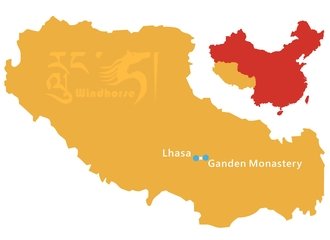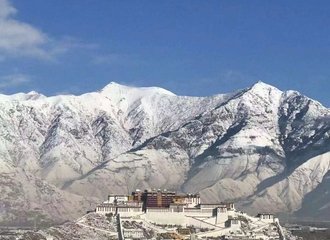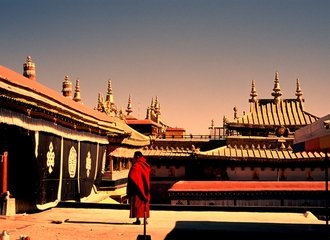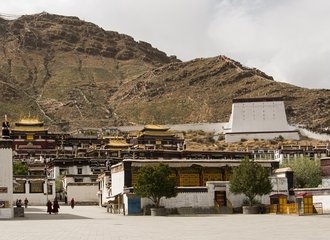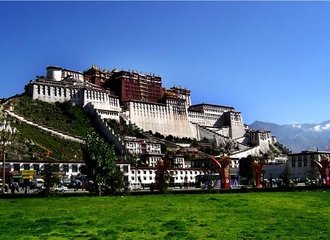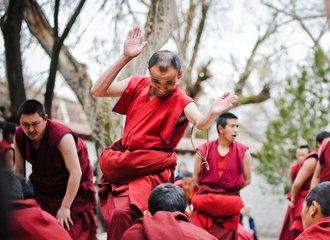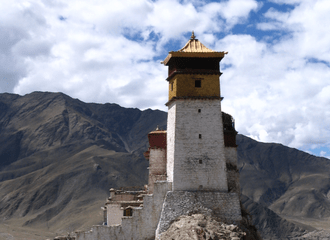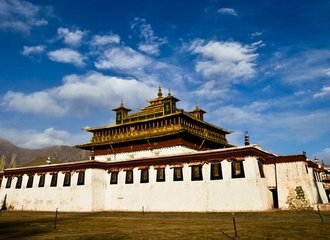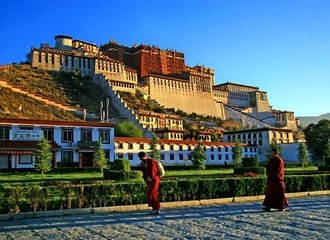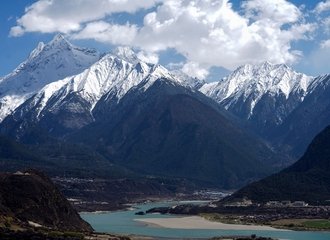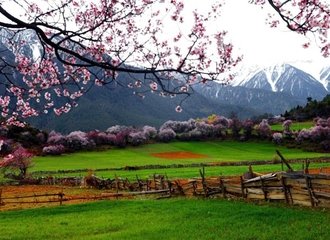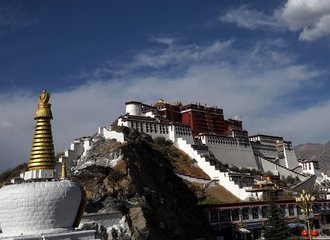The Ultimate Guizhou Travel Guide
Guizhou, referred to as Gui and Qian for short, is a multi-minority province in Southwest China, adjacent to Hunan, Guangxi, Yunnan, Sichuan, and Chongqing on all sides, famous for its magical natural landscape, strong ethnic customs, profound history and culture, and pleasant climatic conditions. In Guizhou, almost everything still keeps its original look and the people still follow the traditional ways for generations to live.
As a mountainous region mainly dominated by mountains and hills, it is known as "eight mountains, one river and one field", which is the only province in China without a plain. Besides, it is one of the most typical areas of karst landform development in the world with the most diverse and colorful karst landscapes. Other than its enchanting mountain ranges, there are huge waterfalls, many rivers, and expansive cave systems, which offer the most off-the-beaten trails for hikers to follow and the best scenery for photographers to shoot. Follow the below travel guide to get started with your wonderful Guizhou trip!
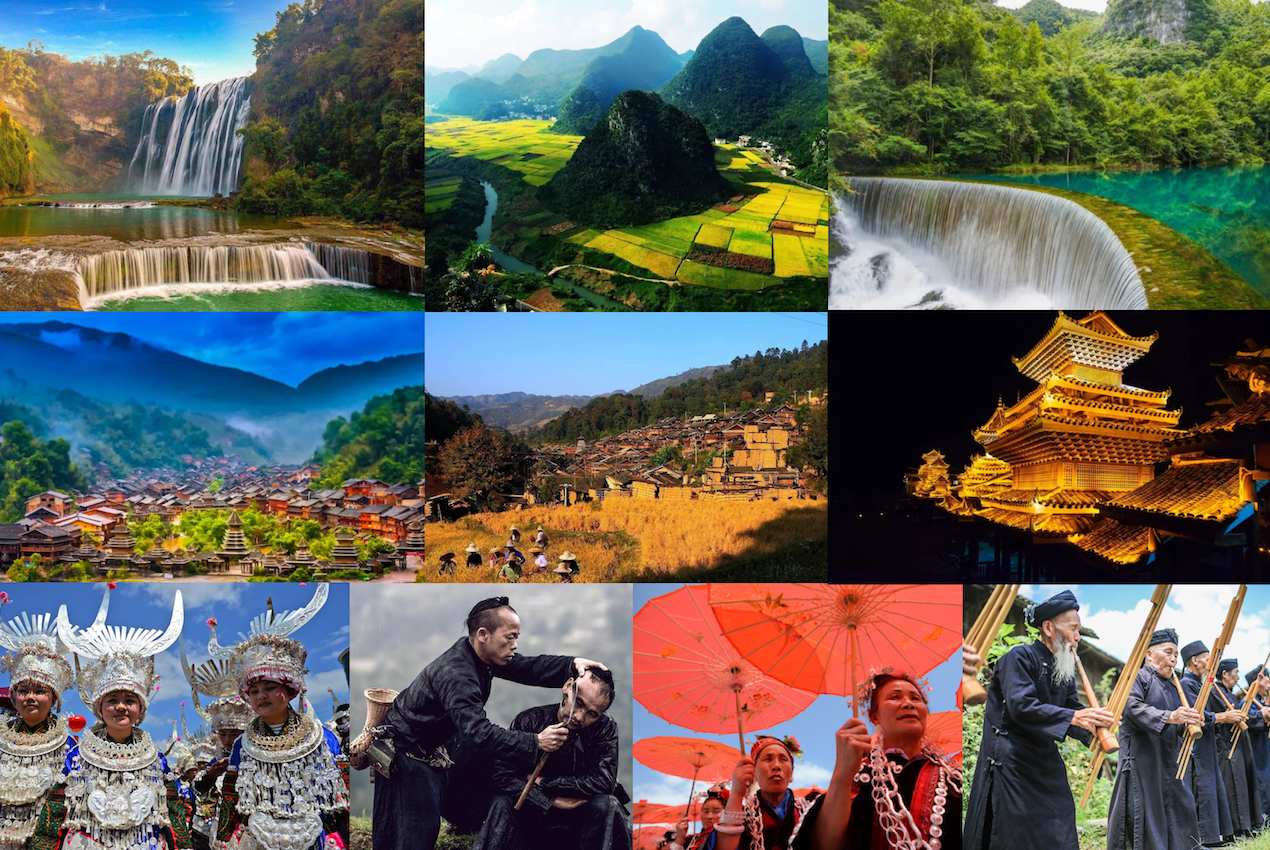

Where to go in Guizhou
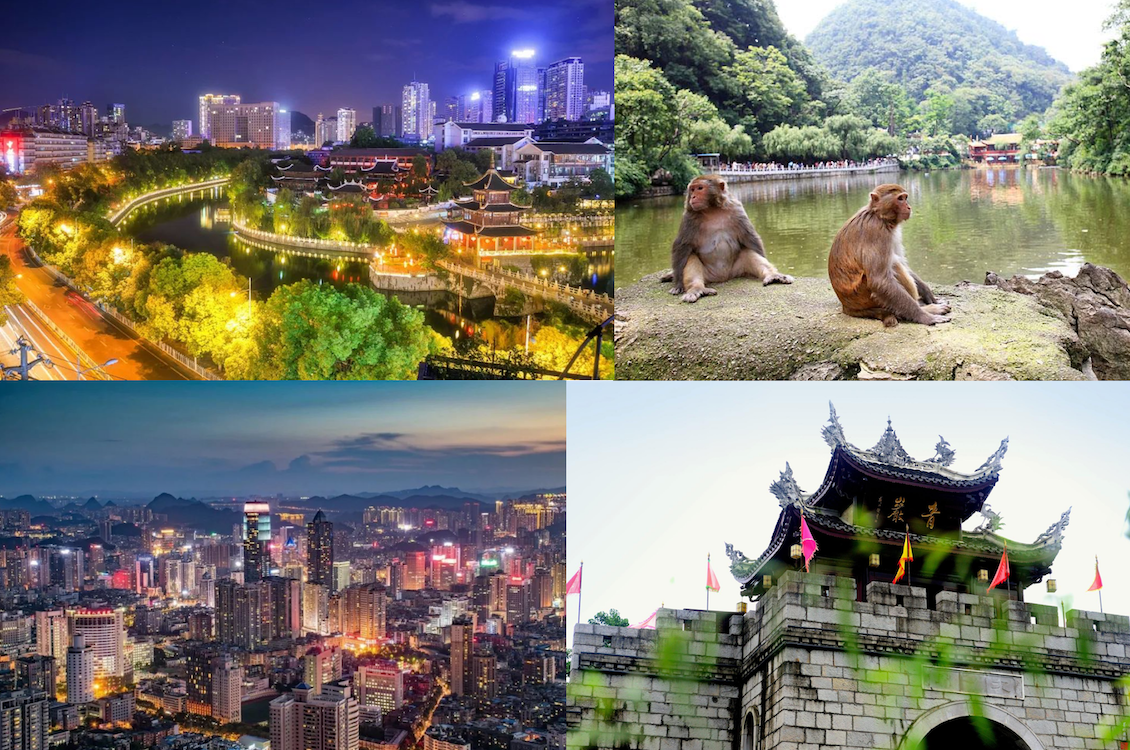
Guiyang - Capital city of Guizhou
Guiyang is a magical city with superb air quality. There are large parks with real mountains and waters in the urban area. It is located on the Yunnan-Guizhou Plateau, but the altitude is not high. It enjoys the plateau climate without experiencing altitude sickness. The highlights here include Jiaxiu Building, Qingyan Ancient Town, Qianling Park, etc. The Siwawa (Guiyang spring roll), sour soup fish, tofu-balls are the gastronomies that you must try when you are in Guiyang. As a modern city, there are many hotels from local guesthouses to 5-star international hotels to meet all the budget requirements.
Getting in and out of Guiyang is very convenient. At present, the major cities in the whole of southern China have opened high-speed trains to Guiyang (about 2-5 hours' ride). Moreover, Guiyang is also open to navigation with most cities across China. Hence, travelers usually use Guiyang as the gateway to start their Guizhou exploration.
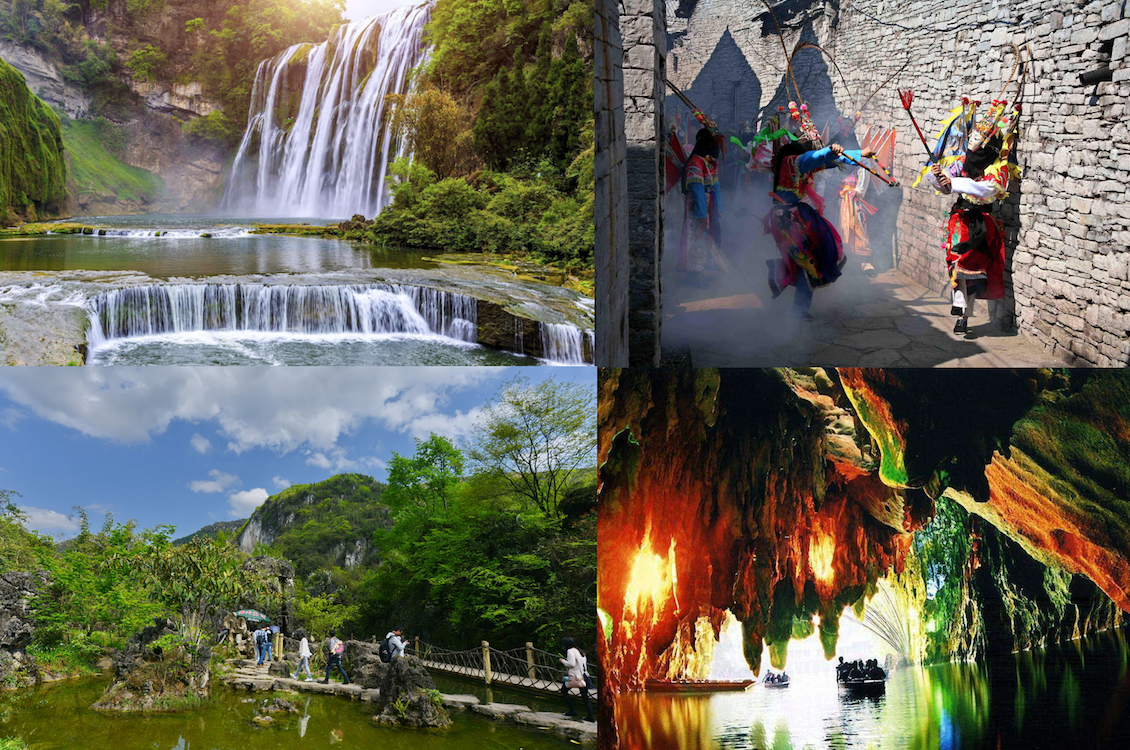
Anshun - Hometown of waterfalls
Known as the "Hometown of Waterfalls in China", "Tunpu Culture Hometown" and "Batik Hometown", Anshun is an excellent tourist city in China with abundant natural and cultural wonders. It is the most mature, typical, and concentrated area of karst landforms. More than 100 waterfalls and more than 1,200 surface caves are densely covered, forming a colorful three-dimensional picture scroll. The representative scenic spot of Guizhou "Huangguoshu Waterfall" is located in Anshun. Others such as Dragon Palace and Tianlong Tunbao are also worth visiting, making it the world's best karst tourism destination, one of China's six major golden tourism hotlines, and the tourist center of western Guizhou.
To Anshun, most visitors consider taking a private car or high-speed train (about an hour) and then drive further to famous attractions like Huangguoshu Waterfall. When you are here, don’t miss the local delicacies including Poshubao (a lard-layered bun), Guojuan, Buyi Chicken, Qingzhen (Islamic) Whole Ox Feast, Yelang Fish, etc. As for the accommodation, with the development of tourism there, there are many hotels opened there from local guesthouses to local 5-star hotels for tourists to choose from, however, you should bear in mind that the condition of the hotels here is not as good as those in bigger cities such as Guiyang, Chengdu, etc.
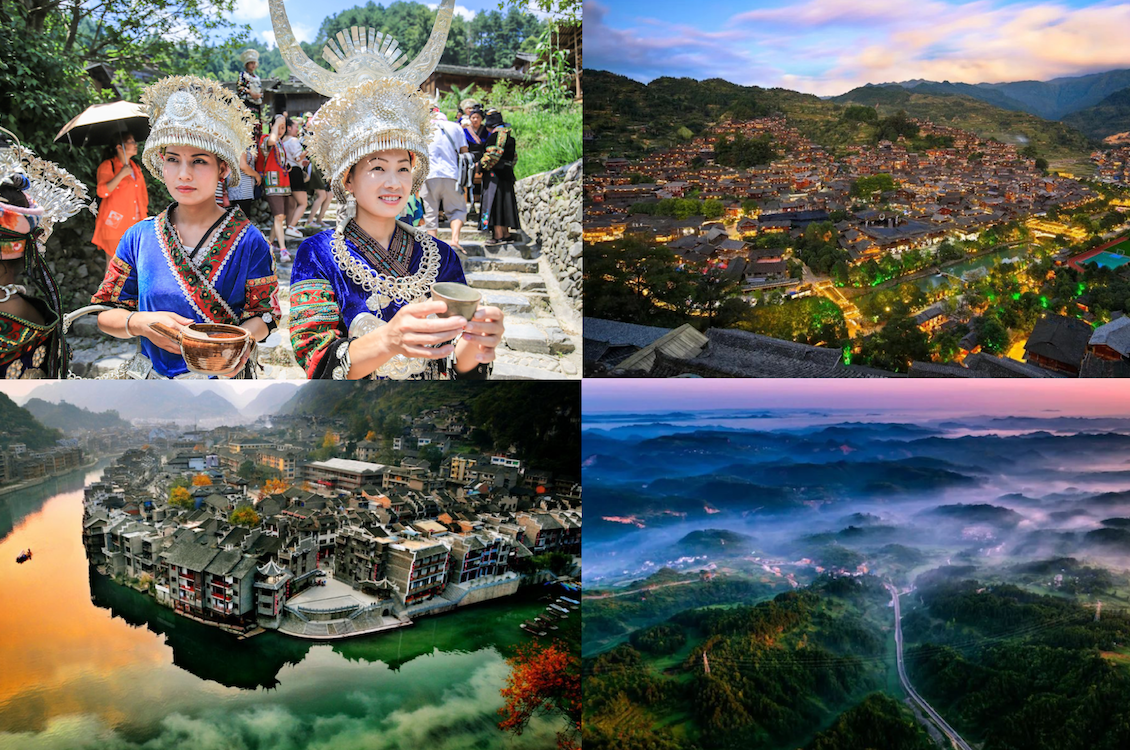
Qiandongnan Prefecture - Miao and Dong’s inhabited area
With Kaili as its capital, Qiandongnan Prefecture is home to more than 20 ethnic groups including Miao minority, Dong minority, Han minority, Shui minority, Yao minority, etc. The folk customs here are simple and strong, and the people are industrious and kind and live in their traditional ways. Coming here to explore the ethnic customs and visit ancient villages has become the most important travel experience in Qiandongnan. Of course, the beauty of the mountains and rivers here is also outstanding, and there are many delicacies including the Miao Long Table Banquet and Kaili Sour Soup Fish.
There are the world’s largest Miao Village and the largest Dong Village, the unique Diaojiaolou, Wind and Rain Bridge, Drum Tower, the grand song of Dong ethnic group like a natural sound, the dazzling embroidery, silver ornaments, batik...a self-contained cultural system, and people live peacefully without fighting against the world. Due to a large number of ethnic minorities, Qiandongnan has hundreds of ethnic festivals. Famous ethnic festivals include the Miao New Year, the Lusheng Festival and Sisters' Meals Festival of Miao people, the March 3rd Song Festival of Dong people, each with its own characteristics.
The must-visit highlights here including Xijiang Qianhu Miao Village, Langde Upper village, Zhenyuan Ancient Town, etc. And to travel around Qiandongnan, it's best to get to Kaili by driving or high-speed trains, then drive to the surrounding villages or attractions. In Kaili, it is possible to find accommodation from local budget hotels to local 5-star hotels, however, in the rest places such as Rongjiang, Zhaoxing, only accommodation from local guesthouses to local 4-star hotels are available.
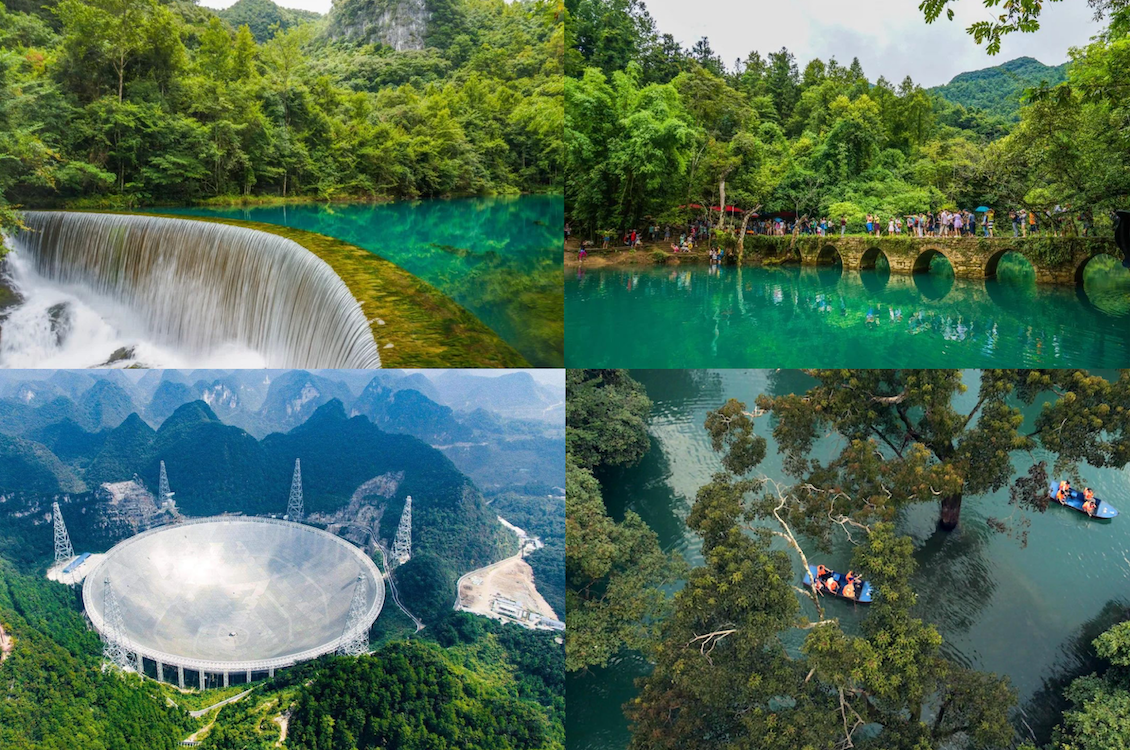
Qiannan Prefecture - Home to Buyi and Miao people
Qiannan is located in southern Guizhou, with a pleasant climate, beautiful mountains and rivers, rich resources, and strong ethnic customs. It was previously unknown on the Guizhou tourism map until the 31st UN World Heritage Conference in June 2007: Libo Karst Scenic Spot was selected as a World Natural Heritage Site, Libo Began to become famous all over the world, this is also the first world heritage in Guizhou, Qiannan has also begun to become a destination for many tourists. Libo Karst Water Forest is the attraction that you must see here, while Zhangjiang beancurd grilled fish and Karst Bayberry Soup are the food that you must try here. The other top highlight is the Chinese Sky Eye (Five hundred meter Aperture Spherical Telescope).
Though Libo is the highlight of the Qiannan trip, however, the transportation here is inconvenient, as it's far away from the surrounding scenic spots, hence, the best way to travel here is to book a tour package or hire a private car. Summer and Autumn are the best seasons to travel here. Libo is only a small county with limited hotel options, however, it is easy for tourists to find a local budget hotel for stay.
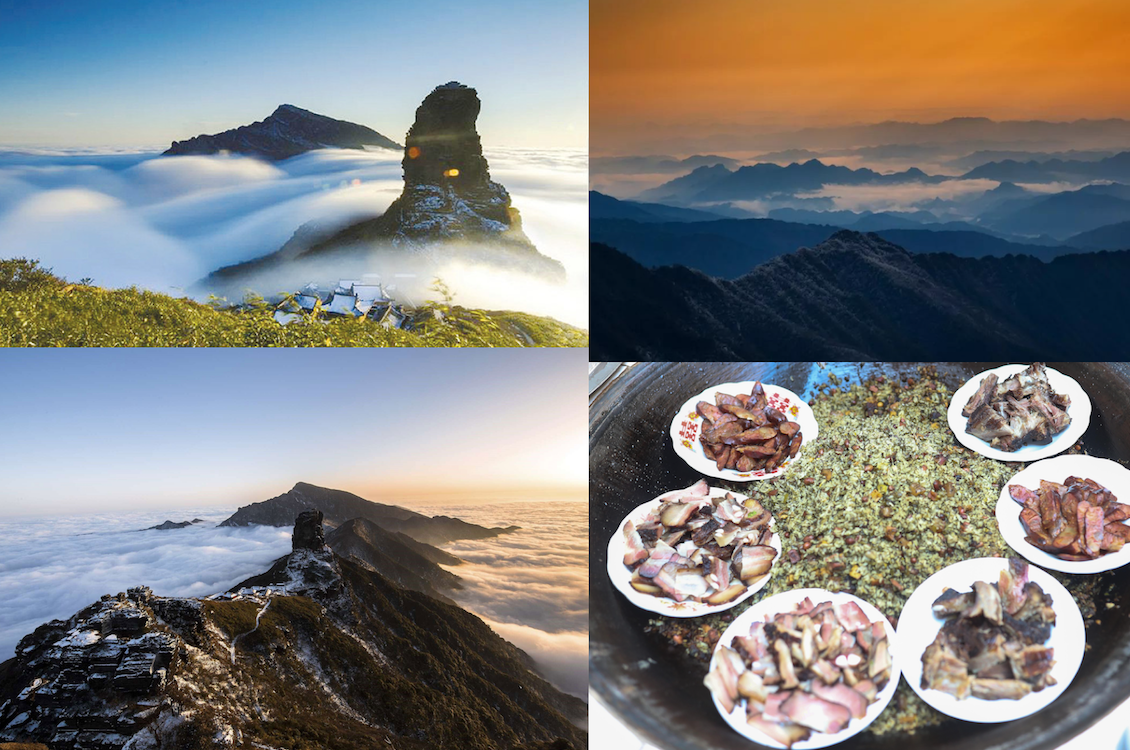
Tongren - Known as "Brahma Pure Land, Taoyuan Tongren"
Tongren is located in the eastern part of the Yunnan-Guizhou Plateau and the hinterland of the Wuling Mountains. Because of the unique charm of plateau landscapes and winding paths, and the mysterious and majestic peak "Fanjing Mountain" in the Wuling Mountains, it is known as "Brahma Pure Land, Taoyuan Tongren". The main purpose of traveling to Tongren is to explore Fanjing Mountain, which is the new world natural heritage site of China and has a reputation as a paradise for animals and plants.
As the nearest airport and high-speed train station to Fenghuang ancient town of Hunan province, travelers usually combine Tongren with their Zhangjiajie and Fenghuang trip. In addition, it can be also easily added to the Qiandongnan journey due to the convenient location. When visiting Tongren, the rice tofu and the traditional food "Shefan" are the gastronomies that you must taste. Travelers can choose to book a room at the local homestay or budget hotels in the Fanjing mountain scenic area or a hotel in the urban area of Tongren for a better condition.
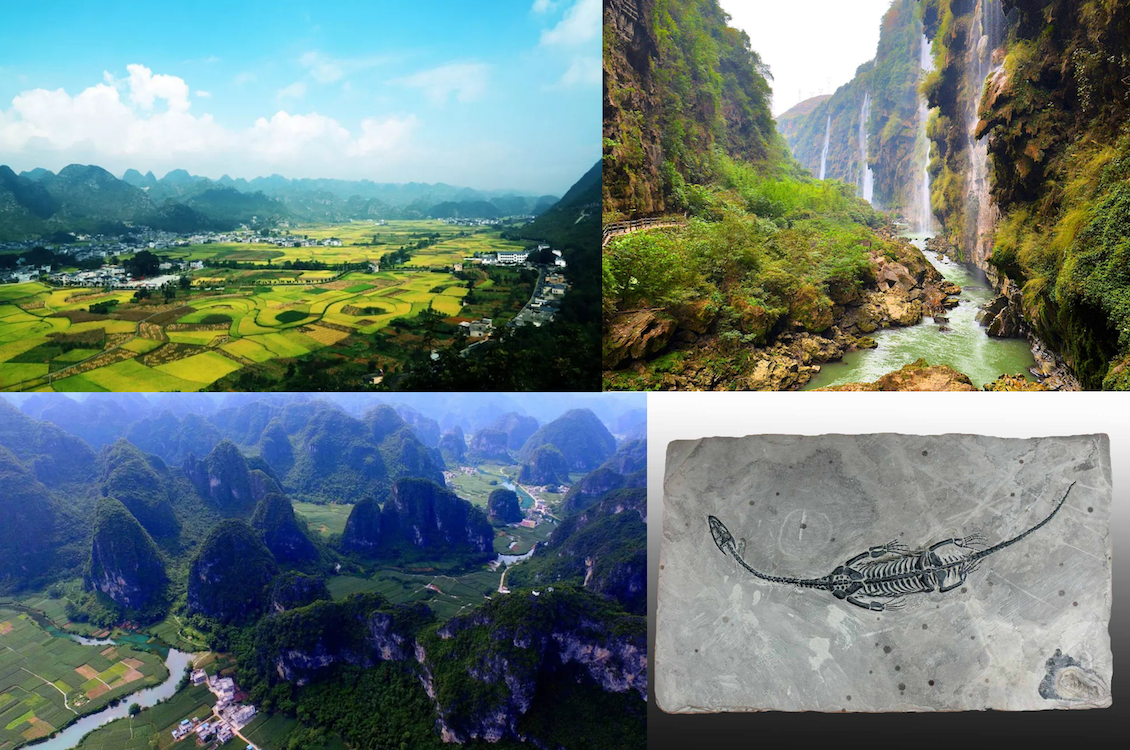
Qianxinan Prefecture - Strong customs and beautiful scenery
Qianxinan is a Buyei and Miao autonomous prefecture with strong ethnic customs, gorgeous mountains and rivers, charming scenery, and abundant tourism resources. There are not only national scenic spots like Maling River Canyon, Wanfenglin, Wanfeng Lake, etc. but also many historical sites including the "Guizhou Dragon" fossil group, the "Xingyi People" ancient human cultural site, the Yelang cultural site, the "Yongli Palace", etc.
Normally, it is recommended to spend 2 days there and spend a night at Xingyi, which offers local guest houses to local 5-star hotels for tourists to choose from. There are many high-speed trains from Guiyang, Nanning, and Kunming to reach Xingyi, in addition, Xingyi airport has flights that are connecting Guiyang together with major cities like Beijing, Shanghai, Chengdu, Xi'an, Nanjing, etc. Shuabatou and Gangzi Noodles are the delicacies that you must try here.

What to see in Guizhou - Top attractions
Hailed as a charming "natural park", Guizhou’s natural scenery is magical and beautiful, with the scenery of mountains and waters in various forms, gorgeous and colorful karst cave landscape, and wonderful wild animals. Mountains, water, caves, forests, and rocks all complement each other and become one. In addition, it is also famous for the ethnic groups' culture, the strong and mysterious unique ethnic customs, and revolutionary relics.

Huangguoshu Waterfall: The largest waterfall in China and Asia. In 1999, it was rated as the world's largest waterfall group by the Guinness Headquarters of the Great World and listed in the Guinness Book of World Records. Normally, it needs at least 3 hours to enjoy and photo its beauty.
Liping-Congjiang-Rongjiang Miao-Dong Cultural Tourism Area: The Miao Village and Dong Township in Qiandongnan Prefecture are the most concentrated and representative in the southern region. Along the "Rongjiang, Congjiang, Liping" line, you can appreciate the most characteristic Miao Village and Dong Township. The highlights here include the famous Zhaoxing Dong Village, Tangan Dong Village, Basha Miao Minority Village, etc. Usually, travelers would spend at least 3 days touring this line.
Langde Upper village (Long-shirt Miao Village): A Miao village with hundreds of families is known as the "Hometown of Chinese Folk Song and Dance Art" and "One Hundred Open-air Museums in China". People here dress in long skirts, hence, the "long skirt Miao". The village is surrounded by mountains and rivers with beautiful scenery. Compared with Xijiang, it’s more primitive and less visited, and you can also enjoy songs and dances of the Miao minority: toasting songs, flying songs of the Miao nationality, and Lusheng dance. To visit its highlights, travelers need at least half-day to 1 day.
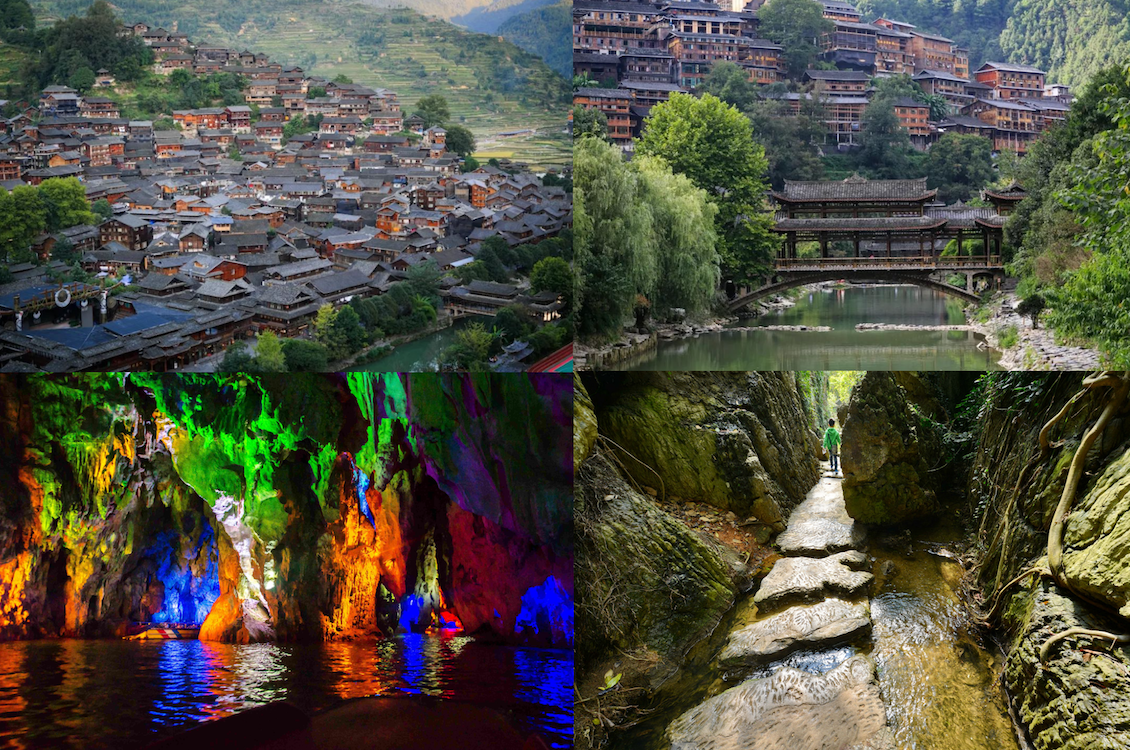
Xijiang Thousand Miao Villages: Connected by 5 natural villages built on the mountain with idyllic scenery of neat terraces, it’s the largest village inhabited by the Miao ethnic group in the world. There is a well-known silversmith village famous for its handmade Miao silver ornaments and extremely high-level craftsmanship. There will be a long table banquet during the festival: dozens of tables are filled with Miao village specialties such as sour soup fish, sauerkraut, bacon, etc., which is absolutely refreshing. It’s recommended to spend a day there.
Dragon Palace: With the longest and most beautiful water cave in China, and various types of karst landscapes, it’s praised by tourists as "the miracle of nature". The rapeseed blossom every March is especially worth seeing, while in winter, there is a unique feeling of cold outside the cave and warm inside the cave. Recommended sightseeing time is at least 3 hours.
Tianxing Bridge Scenic Area: Located at the lower reaches of Huangguoshu Waterfall, mainly for viewing the wonderful combination of rocks, trees, and water. It is a natural basin scenic area transformed from water stone forests and divided into three areas: Tianxing Basin Scenic Area, Tianxing Cave, and Water Stone Forest. Usually, tourists spend about 1-3 hours here.
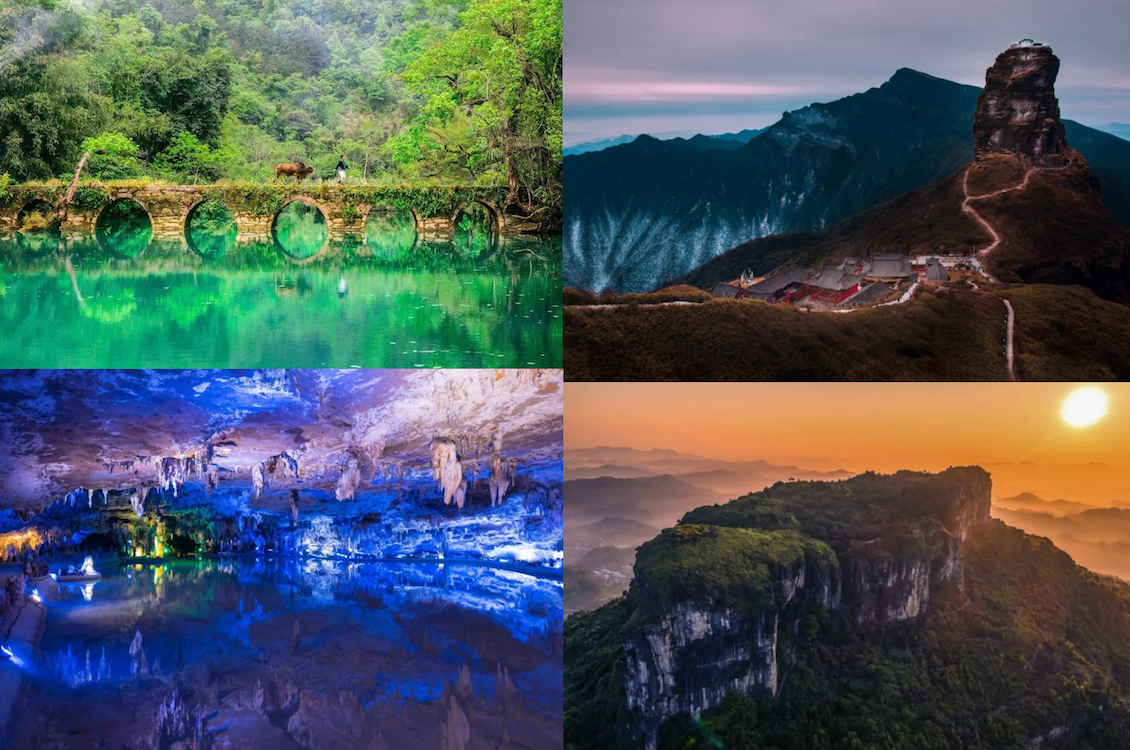
Libo Seven Small Arches (World natural heritage): Known as the "emerald" on the belt of the earth, it has the largest karst primitive forest in the world that has been preserved so far. There are canyons, currents, underground lakes, etc., full of mysterious and peculiar colors. In addition, there are also strong ethnic customs of Buyi, Shui, Yao, and Miao people for you to experience, and local specialties for you to taste. Recommended sightseeing time is at least 3 hours.
Fanjing Mountain: Named after the "Brahma Pure Land", it’s China's top ten summer famous mountains, the famous Maitreya Bodhisattva Dojo, a national nature reserve, a world natural heritage, and a member of the United Nations "Man and Biosphere Reserve Network". To appreciate its breathtaking scenery, travelers are recommended to prepare at least 1 full day there.
Zhijing Cave: The most magnificent and strange cave is called the "Karst Museum". The cave has wide open space and complex rock quality. There are more than 40 types of karst accumulations, including the main types of karst caves in the world. The whole cave is a one-way tour route normally requiring at least 3 hours for sightseeing. As long as you enter the cave, you must walk the entire journey.
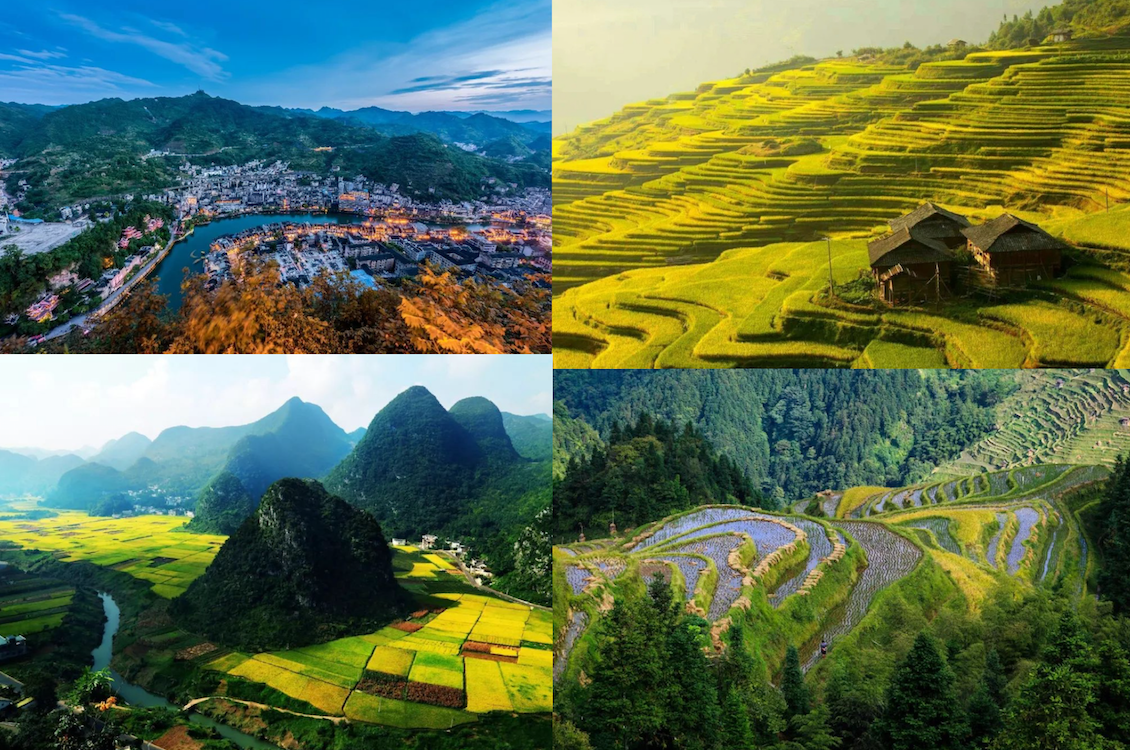
Wuyang River Scenic Area: Composed of the Wuyang River Three Gorges, Yuntai Mountain, Tiexi, Zhenyuan Old Town, and other scenic spots, it is well blended with natural landscapes and historical and cultural sites. It is recommended to spend at least 3 hours there.
Jiabang Terrace: The masterpieces of the Miao villages that have been cultivated for generations, the rice terraces are built on the mountain and show different beautiful lines with the changes of the mountain topography. From the overall form, the Jiabang terraces gather the essence of the world's terraces. The villages in the terraced fields complement each other and blend with nature, embodying the beauty of harmony between humans and nature. Jiabang terraces start to be irrigated in April and May, and early October is the most suitable for photography. Early morning and sunset are the best time for terrace viewing and photography. It is recommended to spend at least 1-3 hours there.
Xingyi Wanfenglin Scenic Area: Composed of nearly 20,000 grotesque karst peaks, it is one of the three major karst landforms in southwest China. The peaks here are dense and in different shapes, making its overall shape perfect. In addition to the beautiful scenery, there are also several Buyi villages, such as Nahui, Leli, and Yulong, where you can appreciate the rich Buyi customs and culture. Recommended sightseeing time is 1-3 hours.
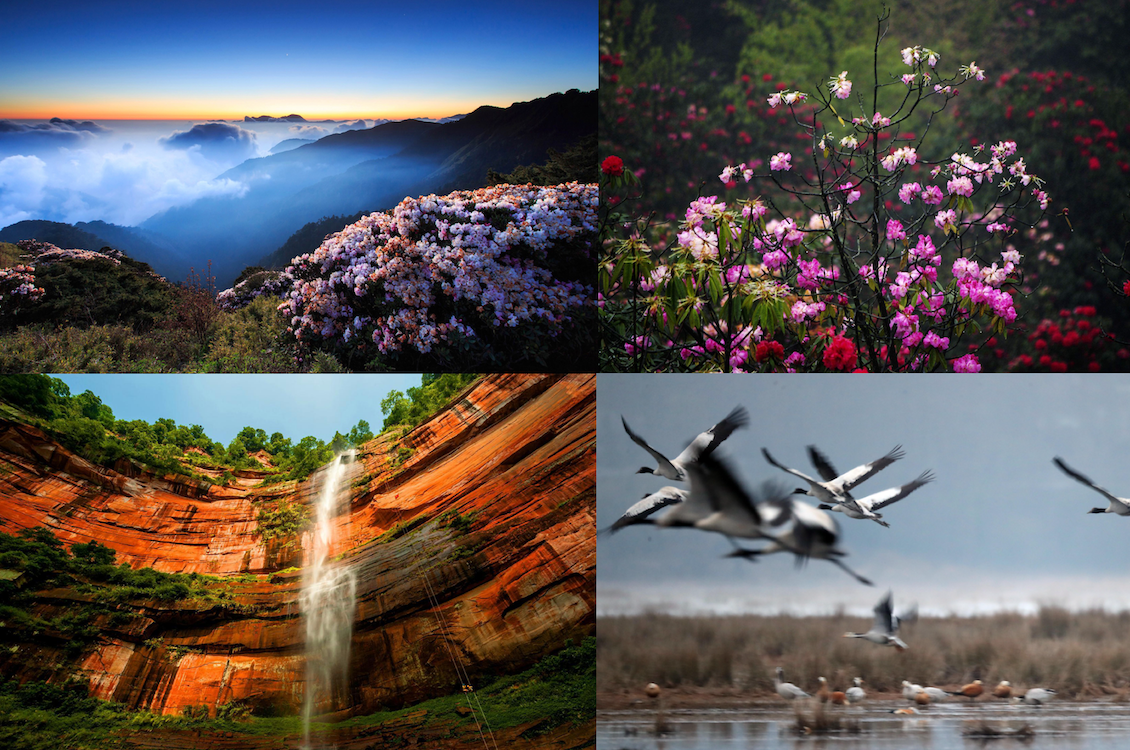
Baili Azalea Nature Reserve in Bijie: The entire natural rhododendron forest has a width of 1 to 3 kilometers, a stretch of more than 50 kilometers, and a total area of 125.8 square kilometers, having the reputation of "the largest natural garden in the world". The scenic spot is where the Yi and Miao people live together. The blossom lasts from March to May, when is also the time that several ethnic minority festivals are held. Recommended sightseeing time is at least 3 hours.
Chishui Danxia Landform (World natural heritage): China’s largest and most beautifully developed Danxia landform. The most complete and representative mid-subtropical forest ecosystem and species diversity are maintained, forming a Danxia landscape combining "The Red Mountains", "Clear Water", "Flying Waterfall", and "Forest Sea". It’s recommended to spend 1-2 days here.
Weining Caohai Lake: With a water area of 46.5 square kilometers and an elevation of 2,200 meters, it is the largest tectonic karst lake in China, the largest and highest lake in Guizhou, and the world's top ten bird watching base to watch the black-necked cranes in winter (from December to March of the following year). Spring is the time to enjoy flowers, and summer is to appreciate the green grasses. Travelers would spend about 1-3 hours to enjoy the scenery.
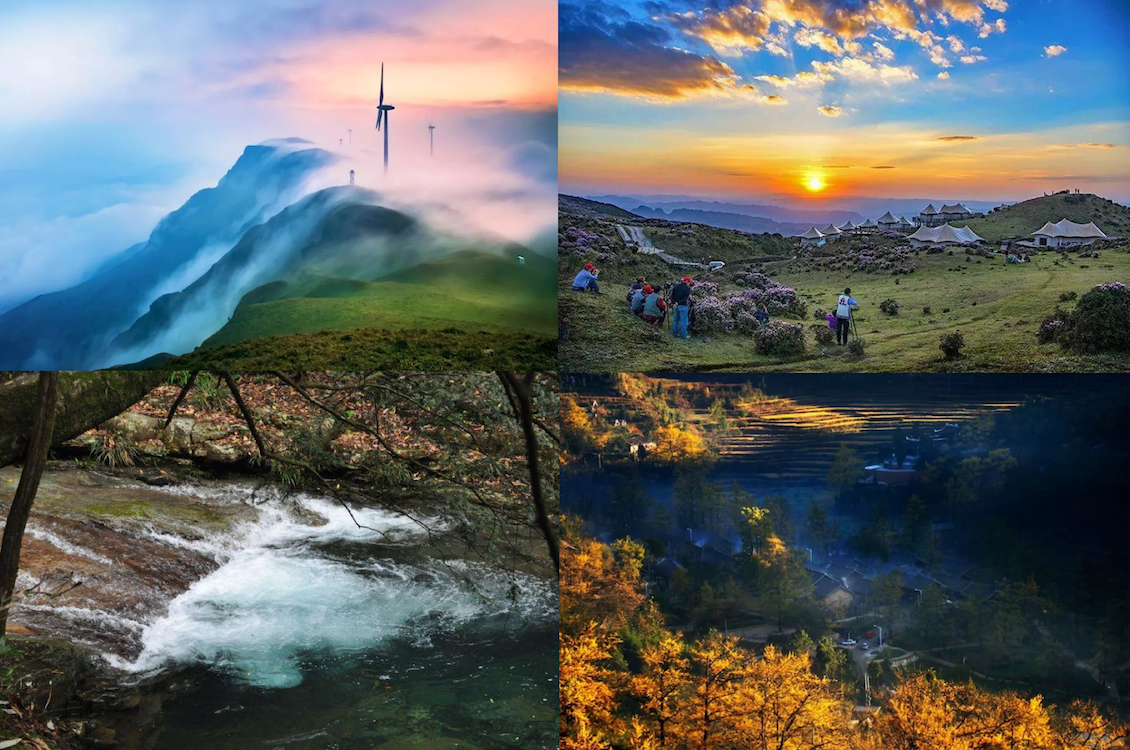
Duyun Doupeng Mountain & Jian River: This primary forest area closest to the city in China has a primary forest coverage rate of nearly 90%. Among them, there are nearly 100 hectares of primitive ancient forest on the high mountain platform at an altitude of 1,800 meters. The roots of the trees all grow in the cracks of the rocks. Jian River is rich in resources and a unique scenic area integrating natural landscape, gardens, bridges, cultural relics, and ethnic customs. Recommended sightseeing time is at least 3 hours.
Tuole Ancient Ginkgo Scenic Spot: Known as "the hometown of ancient ginkgo in the world", the entire Tuole village has more than 1,200 ancient ginkgo plants at the age between 300 - 1200 years old, making it the place with the highest density and best preservation of ancient ginkgo in the world. From the end of October to mid-November, it’s the best viewing period for Tuole Ginkgo.
Panzhou Wumeng Prairie: One of the plateau pastures with the highest elevation and the largest area in the southwest. There are endless and unique plateau pastures, ten thousand acres of plateau dwarf rhododendron forests, beautiful and moving mountain lakes full of magical colors, rich Yi minority culture, a rare natural wonder in the world - Buddha Rays, and incorporating the majestic, peculiar, precipitous, and quiet Niu Peng Liangzi Dashan, Badan Mountain, etc. Recommended sightseeing time is at least 3 hours.

Best time to visit Guizhou
Guizhou belongs to the subtropical humid monsoon climate zone, with warm winter and cool summer, making it suitable for arranging a trip there at any time of the year. While the best seasons to visit Guizhou go to Spring, Summer, and Autumn (normally from May to October) when the climate is mild, the temperature difference is small, and the annual average temperature in most areas is about 15℃.
Due to the low latitude, there is no severe cold in winter and extremely hot in summer, even the coldest January average temperature is 3℃~6℃, and the hottest July average temperature is 22℃~25℃, and the frost-free period is 250-300 days; annual rainfall is about 1300 mm, of which the cumulative 450-600 mm from June to August. The rain and heat are in the same season, and the warm and humid climate is very conducive, making the reproduction and growth of various organisms. Besides, the typical cool summer climate makes Guizhou an ideal summer resort.
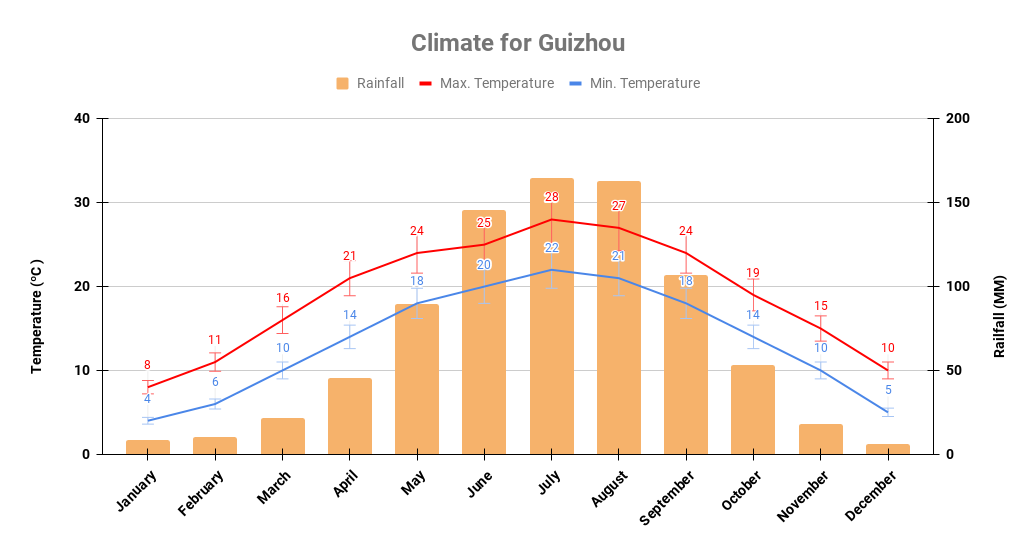

How to get to Guizhou and travel around
Located on the Yunnan-Guizhou Plateau, the traffic density of Guizhou is not as high as that of China's coastal areas. However, However, with the rapid development in recent years, aviation, railways, and expressways have covered the whole of Guizhou, making traveling to Guizhou easier and more convenient.
Flight to Guizhou
At present, Guizhou has formed a route network covering major cities in the province, with 11 opened civil aviation airports, radiating major cities in South China, North China, East China, Northeast China, Southwest China, and Northwest China. Its trunk airport, Guiyang Longdongbao International Airport, has operated 81 routes currently, including 60 domestic originating routes, 15 stopping routes, 2 regional routes, and 4 international routes.
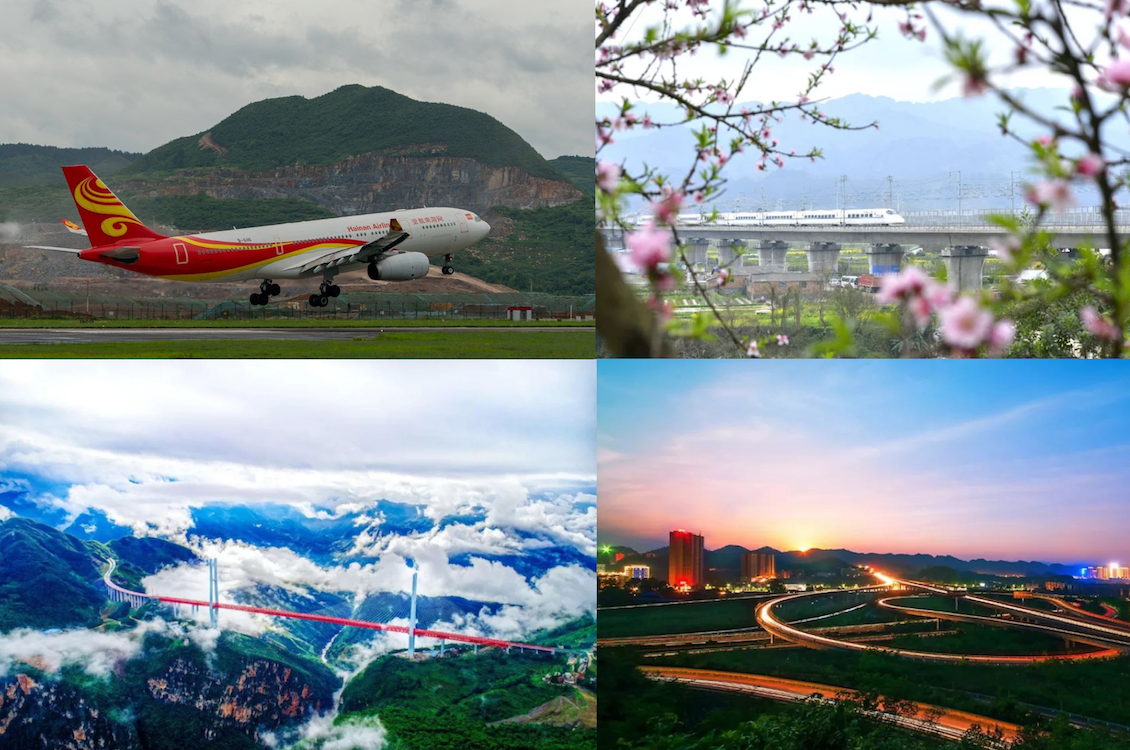
Train to Guizhou
With the continuous construction of the railway networks, the provincial capital Guiyang has now become a high-speed rail hub in the southwest region, connecting Chongqing and Chengdu in the north, Changsha in the east, Kunming in the west, and Guilin in the south. The train ride from the above cities takes about 2-3 hours to reach Guiyang. As of the end of December 2019, all prefecture-level cities except Liupanshui and Xingyi have been connected by high-speed trains.
Travel within Guizhou
With all 88 counties in Guizhou connected to expressways at the end of 2015, Guizhou has become the first province in the west to have expressways in every county, making it easier and more convenient to travel through its territory. Taking long-distance buses to travel within Guizhou is the budget way, however, to fully enjoy the journey, the best way must be hiring a private car through a local China travel agency.

Guizhou basic information
Chinese Name: 贵州省
English Name: Guizhou Province
Capital and the largest city: Guiyang
Location: Hinterland of southwest inland of China
Area: 176,167 km²
Population: 36.23 million (2019)
Climate: Subtropical monsoon climate
Major ethnic groups: Miao, Buyi, Dong, Tujia, Yi, Gelao, Shui, Bai, Hui minorities
Guizhou Ethnic Minorities
Guizhou is a multi-ethnic province, with Han nationality and 17 other ethnic minorities including Miao, Buyi, Dong, Tujia, Yi, Gelao, Shui, Hui, Bai, Yao, Zhuang, She, Maonan, Manchu, Mongolian, Mulao, Qiang, etc., having lived on this land for generations. As of 2014, the total population of ethnic minorities was 12.548 million, accounting for 36.11% of the province's total population, mainly distributed in Qiandongnan Miao and Dong Autonomous Prefecture, Qiannan Buyi and Miao Autonomous Prefecture, Qiannan Buyi and Miao Autonomous Prefecture, 11 ethnic autonomous counties and 233 ethnic townships. For thousands of years, all ethnic groups have lived in harmony and have jointly created a colorful Guizhou culture.

Guizhou Topography
Guizhou terrain is high in the west and low in the east, sloping to the north, east, and south from the west and the middle. It is a typical mountainous province, with mountains and hills accounting for 92.5% of the total area of the province. The four major mountain ranges of Dalou Mountain in the north, Wuling Mountain in the northeast, Wumeng Mountain in the west, and Miaoling Mountain in the middle constitute the topographical framework of the Guizhou Plateau.
The river network is densely distributed, which follows the terrain from west to north, east, and south. It is bounded by the Miaoling Mountains in the middle, with the Yangtze River system to the north, with a drainage area of 115,747 square kilometers, and the Pearl River system to the south, with a drainage area of 60,420 square kilometers.
Guizhou is also one of the regions with the most typical karst landforms in the world. Covering an area of 109,084 square kilometers and accounting for 61.9% of the total land area of the province, the karst landform is widely distributed in Guizhou, with complete morphological types and obvious geographical distribution, forming a special karst ecosystem.

Guizhou distinguishing features
1. Festivals
Guizhou is known as the "Hometown of Hundred Festivals", with more than 1,000 ethnic minority festivals every year. The larger ones include the Miao New Year, the Lusheng Festival and the Sisters' Meal Festival of the Miao people, the "April 8th" of the Miao and Buyi people, the "June 6th" of the Buyi people, the Torch Festival of the Yi people. Folks will sing and dance by dressing in their traditional costumes during the festivals, other interesting activities include Lusheng playing, bullfighting, birds fighting, ancestors worshiping, etc. It's a wonderful experience to join one of the festivals to get close to the local life and learn about their culture and customs. For more details, please read over ethnic minority festivals in Guizhou.
2. Diet
Guizhou cuisine mainly belongs to the Sichuan cuisine series but has its own unique flavor, which is mainly featured for fresh-spicy and sour-spicy. Guizhou’s dry pot series, coupled with the rice wine brewed by the farmers, makes the farmhouse flavor authentic and mellow. The sourness of Guizhou cuisine is not like Shanxi's seasoning with vinegar, but sour soup. Sour soup is a major feature of the Miao nationality’s diet belonging to the hot pot series, especially the sour soup fish is the most delicious. The production of sour soup is divided into vegetable acid, fish acid, meat acid, rice acid, and so on, all are made by natural fermentation of organisms.
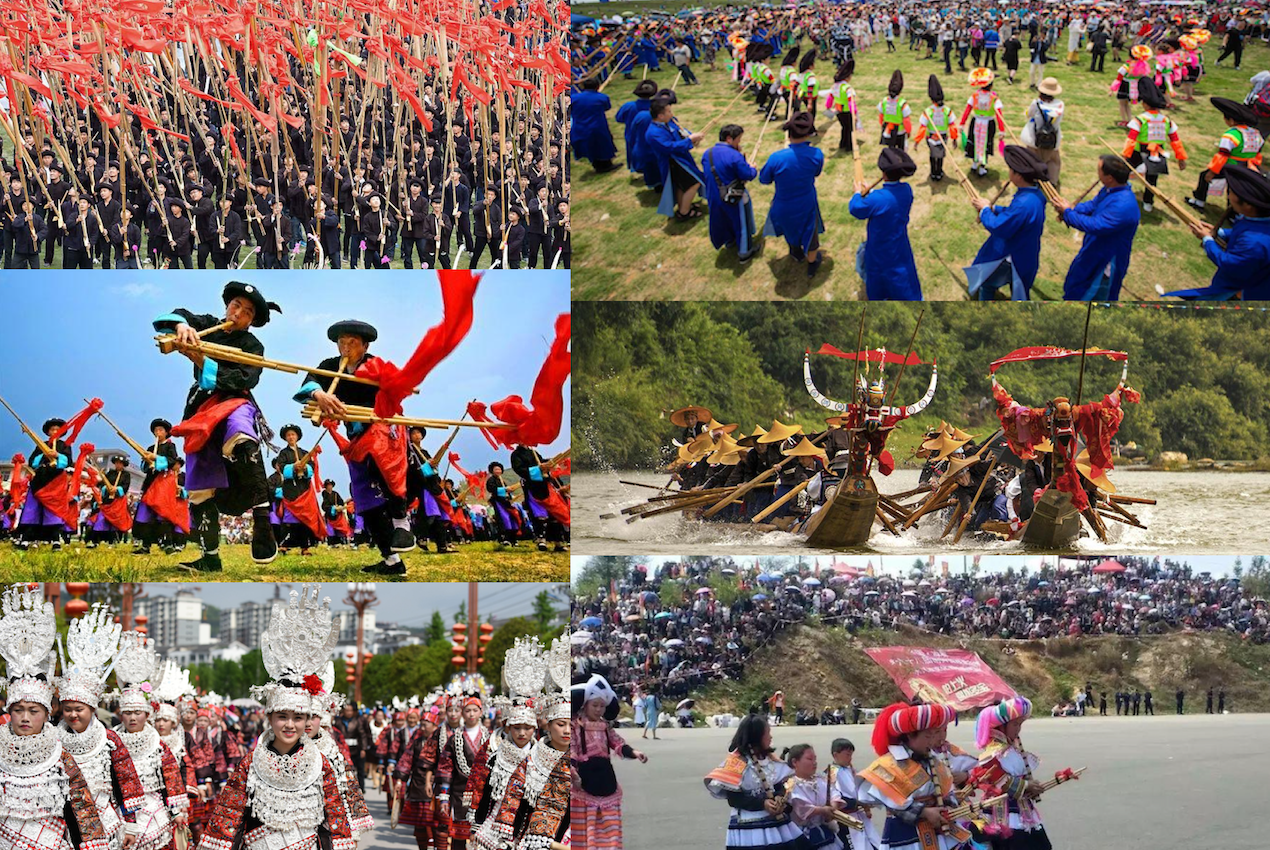
3. Paper-cutting of Miao people
Paper-cutting of Miao People is commonly known as "flower paper" and "cutting flower", and its main purpose is to embroider patterns on Miao costumes. Paper-cutting of the Miao people has a long history and is a folk art closely related to the life of the Miao people. The technique mainly adopts cutting, engraving, and binding. The subject matter covers the myths and legends of the Miao people and the images of flowers, birds, insects, fish, and animals in nature. The content reflects the worship of the ancient totems and nature by the Miao people and contains a lot of mysterious religious and cultural information and primitive artistic features.
4. Batik
Guizhou batik is a family-centric manual sideline business, and mainly popular in ethnic minority areas such as Miao, Buyi, Shui, etc. It is a folk art with a long history, created by working people, and used and appreciated by them. Some have relatively primitive craft forms, such as directly filling red with animal blood, bayberry juice, or cooking and dyeing with rice straw ash mixed with pot smoke, etc., while some crafts are more exquisite, such as the Miao color batik in Huangping and Anshun. Buyi people’s tie-dye in south Qiannan and southwest Guizhou is enviable because of the harmony of tones and the exquisite patterns. Guizhou batik art has formed a unique national artistic style and is the flower of China's distinctive national art.
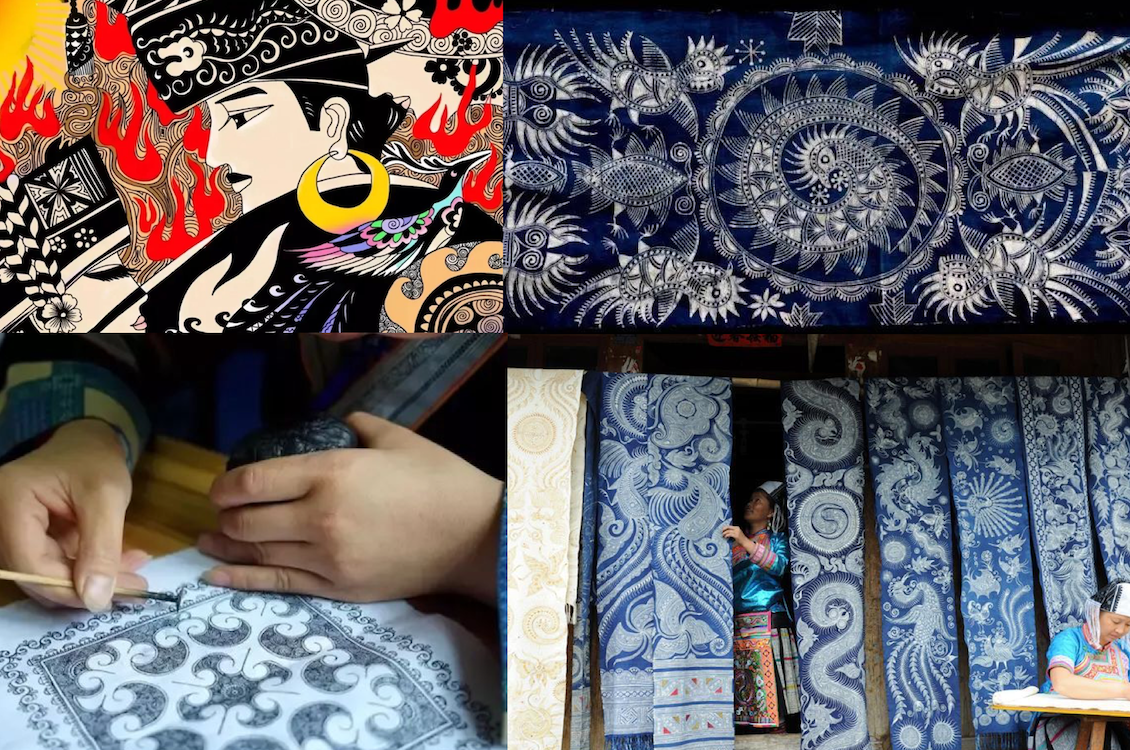

Recommended itineraries and tours in Guizhou
As a place used to be hidden in the mountains, now Guizhou is opening her arms to embrace the world. While traveling to Guizhou, you will have a chance to experience a pleasant climate, unique breathtaking landscapes, mouth-watering cuisine, and colorful ethnic cultures and customs. To have a real taste of Guizhou, travelers would require at least 5-7 days to cover both natural scenery and minority customs, and 10-12 days for in-depth travel. In addition, a Guizhou trip can be as an extension of the Yunnan tour, or combine with the nearby Fenghuang & Zhangjiajie and Guilin & Yangshuo.
- For the first time travelers sufficient in time and looking for a tour with a perfect combination of classic China highlights and unique ethnic folk cultures and customs in Guizhou, this 16 days South China minority tour from Beijing should be the best option.
- For those focusing on the ethnic discovery and picturesque karst landscapes exploration with a short river cruise, it is highly recommended to take one of the following 2 tours: 11 days Guizhou Guilin ethnic culture tour with Li River cruise or 9 days Guilin and Guizhou minority tour with Li River cruise.
- For those planning a deeper discovery of Miao and Dong ethnic culture and the picturesque scenery of Guizhou, we would recommend this 9 days Guizhou Miao Dong Village tour.
- If you are planning a trip with the ethnic discovery in Guizhou, the exploration of the ancient town in Zhenyuan Ancient Town and Fenghuang Ancient City, as well as amazing adventure in Zhangjiajie National Park, you are highly recommended to take this 9 days Ethnic Guizhou and fantastic Zhangjiajie Fenghuang tour.


